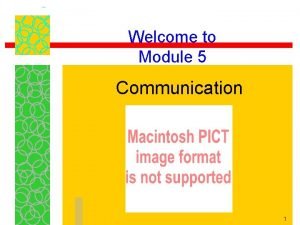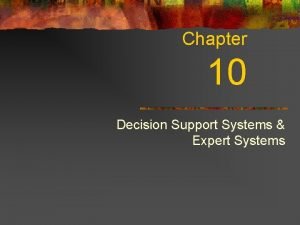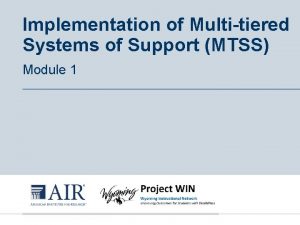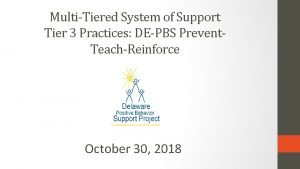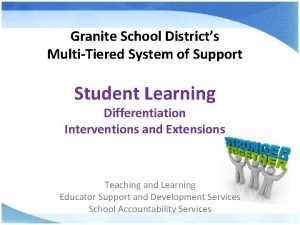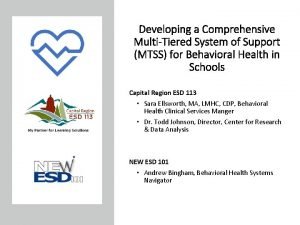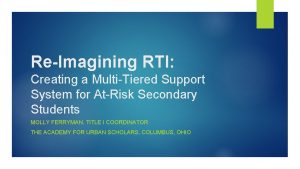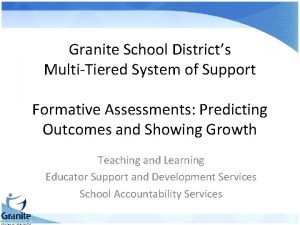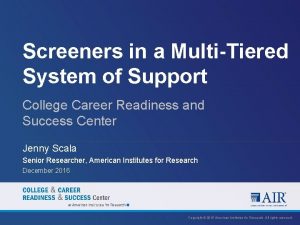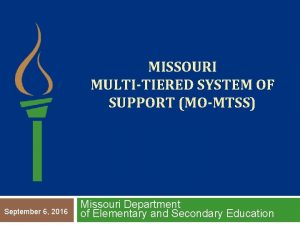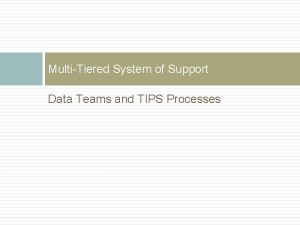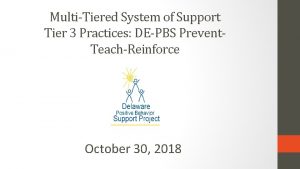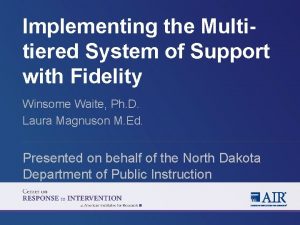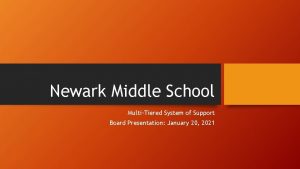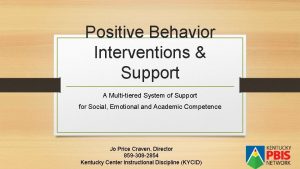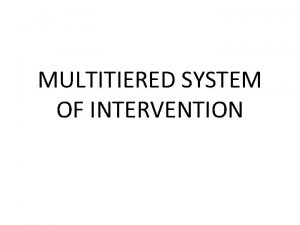Module 4 MultiTiered System of Support for High













































- Slides: 45

Module 4: Multi-Tiered System of Support for High School

Objectives By the end of this module, participants will be able to: § Describe your core instructional program, Tier 1. § Identify effective strategies included in Tier 1, Tier 2, and Tier 3 for literacy § Reflect on our school/district programs and practices for instruction while completing the RTI Handbook. 2

Introduction § Purpose § RTI Handbook guidance 3

Essential Components of RTI 4

Essential Components of RTI 5

RTI Arkansas Model 6

Consider these questions: § Who are the members of your RTI District/ School Team and what are their roles? § How often does the RTI Team meet? § How does the RTI Team monitor RTI implementation in the school(s)? § How does the RTI Team use data to inform decisions? § How does RTI align with other school/district initiatives? 7

STOP the module and complete Section 1: RTI TEAM of your handbook 8

Differentiation in Core Instruction 9

Purpose of Core Instruction § Provide ALL students with high quality instruction § Prepare students for college and career § Meets the needs of all students 10

Elements of Differentiated Instruction § Content—what we teach and how we give students access to the information § Process—how students come to understand “own” the knowledge § Product—how a student demonstrates what the student has come to know and understand 11

Differentiation of Students § Readiness to work with a particular idea or skill at a given time § Interest…in pursuits or topics that they find interesting. § Learning profiles that may be shaped by gender, culture, learning styles, or intelligence preference 12

What Are Differentiated Learning Activities? § Differentiation involves: • Mixed instructional groupings • Team teaching • Peer tutoring • Learning centers • Accommodations to ensure that all students have access to the instructional program § Differentiation is not the same as providing more intensive interventions to students with learning disabilities. 13

Differentiation Reflection § How do you differentiate learning for your students? § What are some strategies that have been most effective? § List the strategies that you have found to be most successful for students and that you wish to see in your RTI framework. 14

STOP the module and complete Section 2: Differentiation of your handbook 15

Core Instruction in Literacy Tier 1 16

Core Instruction Characteristics Focus All students (including students with disabilities and learning differences) Instruction Setting Assessment District core General education Screening, curriculum and classroom continuous instructional progress practices that are monitoring, and research based, outcome aligned with state or measures or district standards, summative and incorporate assessments differentiated instruction 17

Early Warning System Screening Initial Risk Status Analysis: End of 8 th Grade Screening Tool Type of Data Indicator Assessment Results This is the results of the state ACT Aspire Test results assessment given in 8 th **(English, Reading, grade. Mathematics, Science, Writing) Failures Number of Fs in any semester-long course during the 8 th grade. Course Performance Core Course Failure GPA Educational Engagement 1. 2. Brief Description # of core classes failed GPA for each semester and cumulative GPA Absenteeism rate (This The # of days absent 8 th includes suspension grade. time) The # of referrals for Disciplinary Referrals discipline. Red Flag Determine a cut score for determining a red flag. Even one failed course indicates student may be at risk. Track the # of courses failed and red flag based on your decision rules. A student with an F in a core course should be red flagged. GPA under 2. 0 indicates risk and a red flag. 10% instructional time missed indicates risk. Establish # for red flag. 18

Early Warning System Data This is what your spreadsheet might look like. . Course Performance Score Student’s Name John Doe Student #2 Assessment Score 416 F 1 Core F 1 GPA 1. 76 Educational Engagement Score Absences Referrals 8 0 Use of the ASIS and Student GPS systems can have this data available electronically with little effort…you can even set goals GPS system. 19

Semester Screener-Starting th 9 Gr. Type of Data Indicator Brief Description Red Flag Assessment Results Most recent test… may be an interim test. We should be using data from the most recent test that we have given that is standardized, interim, formative, or summative in nature. Cut score Course Performance Failures Number of Fs in any semester-long course during the first year of high school Even one failed course in high school indicates student may be at risk. On-track Indicator # of classes failed divided by ¼ of the classes to graduate minus 1. Two Fs* or a fraction as a result of this calculation. The larger the fraction, the higher the risk. GPA for each semester GPA under 2. 0 indicates student may be at risk Absenteeism rate The # of days absent during the first 20 days of 9 th grade. Again, the 10% rule should be used here. Behavior Documentation How many referrals the student has You can set your own number here. Your team will want to set a reasonable number that is fair but significant. Educational Engagement 20

RTI Model in Literacy: Tier 1 Example: Arkansas High School Tier 1 Instructor: General education teacher Curriculum: Standards-based English Language Arts Curriculum, Adopted materials Frequency: 5 x/week @ 45 minutes per session 21

STOP the module and complete Section III: RTI Literacy Model: Tier I of your handbook 22

Tier 2: Supplemental Instruction and Intervention 23

Continuum of Instructional Support Supplemental Intervention Who receives instruction? § Students not adequately responding to core instruction (Tier 1) Who provides instruction? § General education teacher or other trained professional How is instruction delivered? § In small groups of 3– 5 students § In homogenous groups determined by skill How long is the instruction provided? § 20– 30 minutes, 3– 4 days/week § 10– 16 weeks How is progress assessed? § Progress monitoring and diagnostic measures 24

Supplemental Instruction Focus § Students identified through screening as at risk for poor learning outcomes; verified by progress monitoring or other data § Typically, 15 percent to 20 percent of entire school population § At the high school level, a problem-solving approach should be used if the failure rate in any course, especially core courses, is greater than 10% 25

Supplemental Level Instruction § Evidence based (program or strategy) § Aligns with and supports core instruction § Implementation fidelity based on developer guidelines § Delivered by well-trained staff in optimal group sizes § Decisions based on valid and reliable data and criteria implemented accurately 26

Why Are Supplemental Interventions so Important? § Improves the achievement of students at risk for educational failure § Decreases the need for more intensive interventions and referrals for special education services § Allows for efficient use of time and resources (National Center on Intensive Intervention, 2013 b) 27

Supplemental Interventions Are: 1. Based on evidence 2. Implemented with fidelity 28

Finding a Tier 2 Intervention 29

RTI Model in Literacy: Tier 2 Example: Arkansas High School Tier 2 Instructor: Literacy interventionist Curriculum: Reading Plus Frequency: 3 x/week @ 30 minutes per session 30

Tier 2 Example Literacy Tier II Supplemental Intervention Grade Interventions Reading Plus Delivered by Paraprofessional Focus Area Vocabulary, comprehension, endurance, memory, silent reading fluency Frequency and Duration 3 x 30 min. Location Classroom . Group Size 5: 1 9 Targeted, additional 10 Classroom teacher . 4 x 15 min Classroom 4: 1 small reading group 31

STOP the module and complete Section 2: Tier II of your handbook 32

Tier 3: Intensive Intervention 33

Intensive-Level Instruction Is: § Evidence based or based on validated progress-monitoring methods for individualizing instruction § More intense than secondary-level instruction § Delivered by well‐trained staff in optimal group sizes, based on the ages and needs of the students (National Center on Intensive Intervention, 2013) 34

Continuum of Instructional Support Intensive Intervention Who receives instruction? § Students not adequately responding to supplemental intervention Who provides instruction? § Intervention specialist or special education teacher How is instruction delivered? § Individually or in groups of no more than three students (The IRIS Center, 2010) 35

Intensive-Level Setting § Intervention may take place in a general education classroom or other appropriate setting. § Decisions are made on a case‐by‐case basis. (National Center on Intensive Intervention, 2013 a) 36

Finding a Tier 3 Intervention 37

RTI Model in Literacy: Tier 3 Example: Arkansas High School Tier 3 Instructor: Specialist or special education teacher Curriculum: Lexia Reading Frequency: 5 x/week @ 45 minutes per session (3 students) 38

RTI Handbook: Tier 3 Literacy Tier III Intensive Intervention Grade K Interventions Delivered by Frequency and Duration Focus Area Group Size Location 1 2 3 4 5 39

STOP the module and complete Section 2: Tier III of your handbook 40

DATA-BASED DECISION MAKING § Which student’s may be at-risk for academic failure? § How well are students responding to supplemental, tiered instruction/intervention? § How do students move within tiers of interventions? (National Center on Intensive Intervention, 2013 a) 41

Determining Initial Risk Status § Primary Data Source § Secondary Data Source § Who is involved in making this decision? § Frequency of Initial Risk Status decisions § Decision Options and Criteria § Cut Points (by grade level) 42

Determining Student Response to Intervention § Primary data source § Secondary data source § Who is involved in making this decision? § Frequency of response to intervention (per tier) § Decision Options and Criteria § Cut Points (by grade level) 43

Action Plan § Initial RTI Professional Development § Identify weaknesses or holes within our plan § Identify strengths within our curriculum § Identify professional development needs § Reflection and next steps 44

In Summary Effective instruction should: § Be along a continuum of increasingly intense levels of support § Be evidence based and implemented with fidelity § Include interventions that are used consistently by a trained individual § Be matched to student need based on data § Aim to prevent further academic challenges 45
 High expectations high support
High expectations high support C device module module 1
C device module module 1 Support module
Support module Oral communication module 5
Oral communication module 5 Kernel linux security module m1 support
Kernel linux security module m1 support Grammatical signals examples
Grammatical signals examples Dss vs expert system
Dss vs expert system Difference between dss and expert system
Difference between dss and expert system Decision support system and expert system
Decision support system and expert system Kontinuitetshantering i praktiken
Kontinuitetshantering i praktiken Novell typiska drag
Novell typiska drag Tack för att ni lyssnade bild
Tack för att ni lyssnade bild Ekologiskt fotavtryck
Ekologiskt fotavtryck Shingelfrisyren
Shingelfrisyren En lathund för arbete med kontinuitetshantering
En lathund för arbete med kontinuitetshantering Adressändring ideell förening
Adressändring ideell förening Tidbok
Tidbok A gastrica
A gastrica Förklara densitet för barn
Förklara densitet för barn Datorkunskap för nybörjare
Datorkunskap för nybörjare Stig kerman
Stig kerman Mall för debattartikel
Mall för debattartikel Magnetsjukhus
Magnetsjukhus Nyckelkompetenser för livslångt lärande
Nyckelkompetenser för livslångt lärande Påbyggnader för flakfordon
Påbyggnader för flakfordon Vätsketryck formel
Vätsketryck formel Publik sektor
Publik sektor Kyssande vind
Kyssande vind Presentera för publik crossboss
Presentera för publik crossboss Vad är ett minoritetsspråk
Vad är ett minoritetsspråk Kanaans land
Kanaans land Klassificeringsstruktur för kommunala verksamheter
Klassificeringsstruktur för kommunala verksamheter Fimbrietratt
Fimbrietratt Bästa kameran för astrofoto
Bästa kameran för astrofoto Centrum för kunskap och säkerhet
Centrum för kunskap och säkerhet Verifikationsplan
Verifikationsplan Mat för idrottare
Mat för idrottare Verktyg för automatisering av utbetalningar
Verktyg för automatisering av utbetalningar Rutin för avvikelsehantering
Rutin för avvikelsehantering Smärtskolan kunskap för livet
Smärtskolan kunskap för livet Ministerstyre för och nackdelar
Ministerstyre för och nackdelar Tack för att ni har lyssnat
Tack för att ni har lyssnat Mall för referat
Mall för referat Redogör för vad psykologi är
Redogör för vad psykologi är Stål för stötfångarsystem
Stål för stötfångarsystem Atmosfr
Atmosfr



